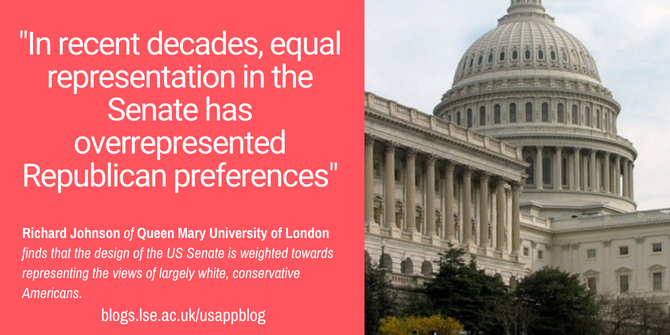 The United States Senate represents almost 330 million people across 100 seats. But with two seats per state, which can have dramatically different populations, the body is far from equally representative. In new research, Richard Johnson explores a hypothetical alternative version of the Senate, one where a state’s representation is allocated according to its population. He finds that such a Senate would reverse the outcomes of many key voters in Democrats’ favor, including on bills relating to LGBT rights, abortion, and gun control. The thought experiment, he writes, shows that the malapportionment of the current Senate makes it easier for Republican presidents to pursue their objectives.
The United States Senate represents almost 330 million people across 100 seats. But with two seats per state, which can have dramatically different populations, the body is far from equally representative. In new research, Richard Johnson explores a hypothetical alternative version of the Senate, one where a state’s representation is allocated according to its population. He finds that such a Senate would reverse the outcomes of many key voters in Democrats’ favor, including on bills relating to LGBT rights, abortion, and gun control. The thought experiment, he writes, shows that the malapportionment of the current Senate makes it easier for Republican presidents to pursue their objectives.
The US Senate is rare internationally and unique within the United States in that it takes no account of population differences between its representational units. Each state receives the same number of senators, even though one state, California, has a greater population than Canada and another, Wyoming, has fewer people Washington, DC (which itself lacks any Senate representation).
To liken this system to the rotten boroughs of the pre-reformed eighteenth-century British Parliament is no exaggeration. The Founding Fathers themselves drew this analogy at the 1787 Constitutional Convention in Philadelphia. Gunning Bedford, a delegate from Delaware, praised the rotten boroughs in the British Parliament as a safeguard of liberty from the dangers of mass democracy:
‘Look at Great Britain. Is representation there less unequal? But we shall be told again that that is the rotten part of the Constitution. Have not the boroughs however held fast their constitutional rights?’.
One person, one vote
The US Constitution has been radically transformed since those undemocratic days, with subsequent amendments reinforcing the idea of the basic political equality of all Americans. Chief among these is the principle of ‘one person, one vote’, which demands representational units of roughly equal size or that the votes of representatives are weighted to account for population differences.
Over half a century ago, the US Supreme Court struck down a variety of apportionment schemes in state legislatures which violated the ‘one person, one vote’ principle. Justice William Douglas wrote in Gray v Sanders (1963),
‘The conception of political equality from the Declaration of Independence, to Lincoln’s Gettysburg Address, to the Fifteenth, Seventeenth, and Nineteenth Amendments can mean only one thing—one person, one vote’.
This idea was echoed in subsequent rulings. Chief Justice Earl Warren wrote in Reynolds v Sims (1964), ‘legislators represent people, not trees or acres. Legislators are elected by voters, nor farms or cities or economic interests’. Justice Hugo Black acknowledged in Wesberry v Sanders (1964) that while ‘mathematical precision’ might not be possible, ‘the high standard of justice and common sense’ demanded ‘making equal representation for equal numbers of people’.
It was once said that if the Senate’s scheme of apportionment was not in the Constitution, it would almost certainly be unconstitutional because it violates these basic principles of democratic self-rule. Article V of the US Constitution makes changing Senate malapportionment impossible without the consent of every state, but this should not prevent political scientists from exploring the policy consequences of this blatantly undemocratic feature at the heart of the US political system.

Credit: Scrumshus [Public domain]
What if the representation of the US Senate was more proportional?
In new research, Professor Lisa Miller of Rutgers University and I did just that. We imagined what a reapportioned Senate might look like. We preserved some of the Senate’s unique features – its small size (100 senators) and the states as the territorial basis of representation — but we also gave some recognition to state population differences. States were allocated between 1 and 10 senators according to their population, which still substantially overrepresented small states. For example, the population disparity between the largest and smallest state is 67:1, but under our apportionment scheme the representational difference would be only 10:1.
A clear pattern emerged in the types of states which would be the winners and losers of a more proportional scheme of Senate apportionment. States with high populations tend to be more metropolitan, more racially diverse, more unionised, more liberal, and more Democratic. These clear representational disparities have been shown by other researchers, especially the fact that non-white voters are disproportionately concentrated in the states which have the worst Senate representation.
How might a reformed Senate vote?
Professor Miller and I undertook a second stage of our analysis. We wanted to see how these demographic disparities translate into actual outcomes in the Senate itself. We applied our reapportionment as a weighted voting scheme on 804 of the most significant votes taken in the Senate since 1961, the first time the chamber sat for an entire session with 100 members (after the additions of Hawaii and Alaska).
When senators’ roll-call votes took state population differences into account, we found that Democratic Party preferences tended to do better compared to those favoured by Republicans. On a number of these key votes, we found that even our modest scheme of apportionment was enough to reverse outcomes, often in the Democrats’ favour. The biggest changes occurred on bills relating to LGBT rights, abortion, and gun control.
The Senate has a unique role in the US political system in confirming presidents’ appointees to the executive and judicial branches. Our findings revealed that several appointees, most of them from Republican presidents, would have failed to win Senate confirmation under our more proportional scheme of apportionment. Simply put, Senate malapportionment makes it easier for Republican presidents to pursue their objectives.
Our weighted reapportionment scheme is intended to be indicative of the policy impacts of a core structural feature of US politics, not a definitive counterfactual. We cannot say for certain that a particular bill would definitely pass or fail were it not for equal state representation. Too many other factors would also be altered if senators’ votes reflected state population, such as their strategic behaviour or willingness to use the filibuster. Nonetheless, the ideological pattern is unmistakable.
When equal representation is not representative
Our analysis strongly suggests that, in recent decades, equal representation in the Senate has overrepresented Republican preferences. Even modestly taking population differences into account generates higher support for key left-of-centre policy goals, better reflecting the viewpoints of most American citizens.
The principle of ‘one person, one vote’ is a keystone of representative democracy, as the Warren Court acknowledged. Although some federal systems allow for a departure from this principle to account for territorial or at-risk minority representation, such deviations diminish the representation of people in more populous parts of the country. Diminishing their representation requires justification beyond ‘this is the way they wanted it in the 1780s’.
Even if reform is not forthcoming, it is crucial for political scientists to understand which groups benefit most from the existing rules of the game. Under equal state representation, the minority views of largely white, conservative Americans are the winners.
- This article is based on the paper, ‘The Conservative Policy Bias of US Senate Malapportionment’ a recent article in PS: Political Science and Politics.
- Please read our comments policy before commenting.
- Note: This article gives the views of the author, and not the position of USAPP – American Politics and Policy, nor the London School of Economics.
- Shortened URL for this post: https://bit.ly/3VJQbY0






